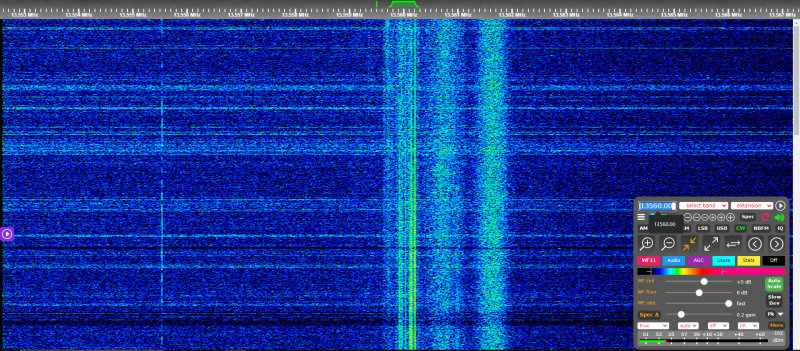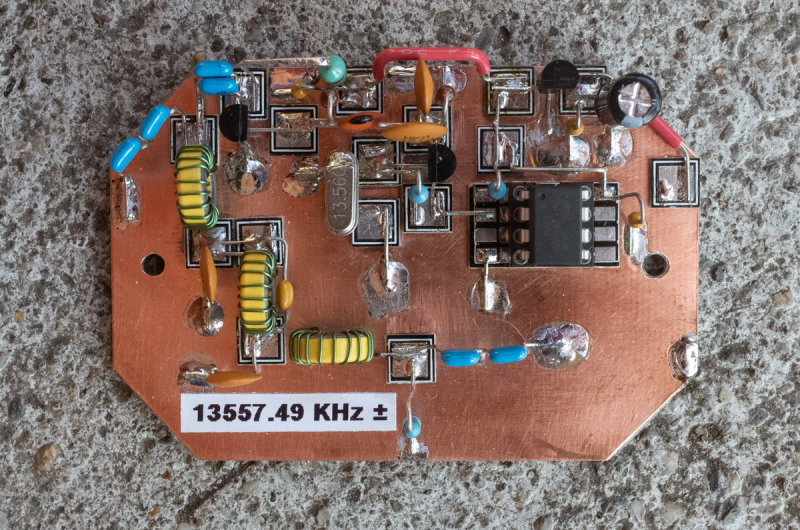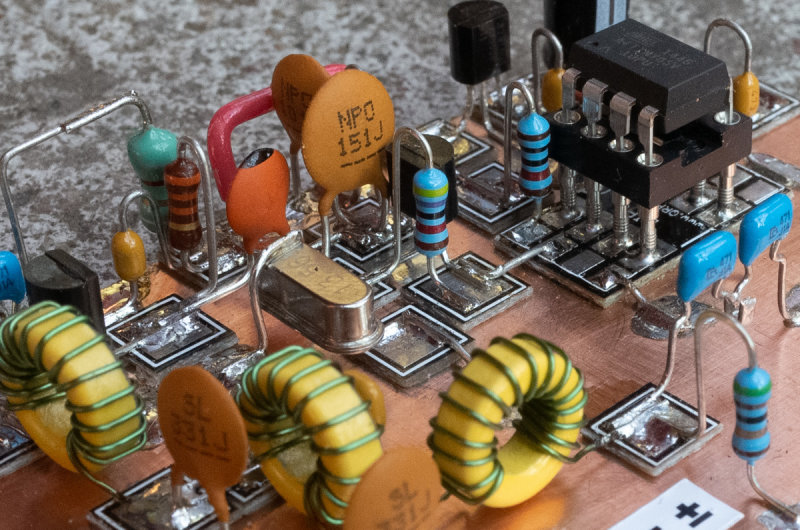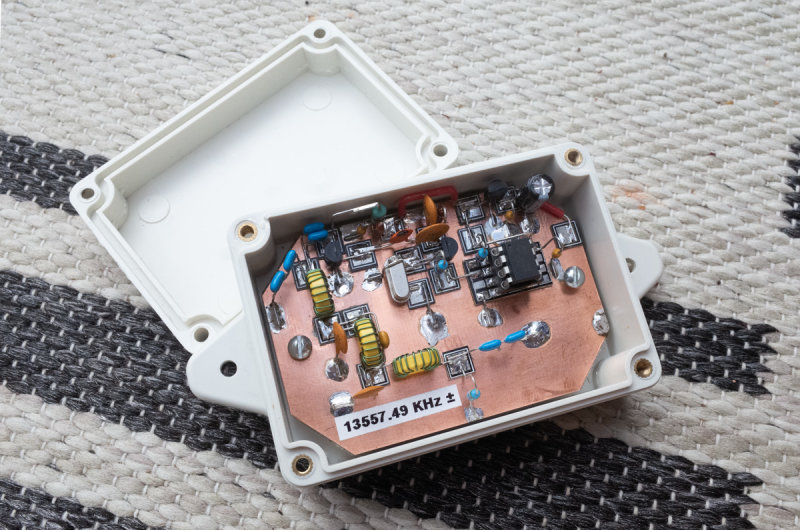I haven’t been building much at all, for quite a long time now. However, the urge occasionally returns. When it does, it’s wonderful to have a small stash of parts on hand, so I can pull the soldering iron out and start building before the desire dissipates. I’ve been interested in beacons for a while, and this interest has followed a logical progression. I first noticed that my interest in talking with other hams over the air using phone (i.e. SSB) was waning. During this time, I would still check in daily with the Noontime Net on 40M (now on 7284 KHz). A quick check-in to a net was fine, and it was good to hear the other stations, many of whom were regulars, also check-in, and have the occasional quick conversation. In addition I noticed that my inclination towards CW QSO’s was also diminishing. I’m not exactly sure why. I enjoy talking with close friends, acquaintances, and neighbors in person, but my enthusiasm for chatting with relative strangers who I can’t see, and don’t know that well, all but disappeared. Too many QSO’s seem very cookie cuttter. Either that, or the conversation is about subjects that don’t interest me.
My main interest in amateur radio was fast becoming the medium of radio communication and the science behind it, rather than the content. I enjoyed quick contest exchanges, as it was a way of seeing where my signal was getting to. Some folk dislike contests, preferring to ragchew, but I find the average ragchew on the bands rather dull. Mike Rainey AA1TJ referred to brief QSO’s as being akin to high-fiving someone when you’re walking down the street. It’s an acknowledgement – a quick, “Hi! It’s good to see you. Talk later!” If you just built something, it’s good to know that it works, and a way to marvel in the mechanism of propagation that made it all possible.
This is why I like beacons. The ones I listen to send CW at regular speeds. I tend not to look for QRSS beacons, or data signals. I like CW that I can listen to and decode in my head, even if it’s just a few letters that are constantly repeated. I can put in the work to decode a very weak signal from a QRP (and often QRPp) beacon, figure out roughly where it is in some cases, and feel the satisfaction of having received a very weak signal, without listening to some chap talking about the model number of his transceiver, his latest medication, his political/social opinions, or whether he mowed the lawn and watered his plants today.
I’ve probably explained this before, but there are two main types of beacon I like to listen out for. The first are the so-called “unlicensed HF beacons” (for which read pirate). They tend to operate in the lower half of the HF spectrum. The lowest frequency one I know of is on 2097.3 KHz, is located somewhere in the southwest (many of them are in the SW deserts), and is relatively high power – probably in the range of 5-15W. It sends the letter A once every 10 seconds (approximately). There are a number clustered around 4096 KHz (a popular crystal frequency), quite a few around 8000 KHz, and others up to about 8500 KHz. A good one to listen out for, is the fairly new Desert Whooper, on 4095.65 KHz. It must be relatively high power, as I have heard it regularly in 6 Western states, on a recent campervan trip, with a portable receiver and set-top whip. It sends a whooping sound for a few minutes then, in CW, it sends the battery voltage, the outside temperature, the inside temperature, and a number that is related to the solar panel voltage. Then, if I remember correctly, it sends it’s ID a few times (DW, for Desert Whooper), and goes back to whooping for the next few minutes. The current list of known active unlicensed HF beacons is here, on the very excellent HF Underground forums –
https://www.hfunderground.com/board/index.php/topic,9478.0.html
I’m a bit too chicken to deploy one of these types of beacons, partly because I’m a licensed amateur. Also, how do you really know that your HF beacon is not operating on, or close to, some frequency that is used for critical communications? Certainly, there are published bandplans, but I’m not sure how much detail they really go into. On top of that, I just cannot bring myself to leave something that emits RF in a remote location such that I would have trouble getting back there quickly, were the beacon to malfunction. It’s a control thing, I suppose. I’m responsible for my stuff, and I like to be able to switch it on and off, and service it, at will. I know that the likelihood of a 100mW HF beacon interfering with critical communications is pretty unlikely but even so. Besides, as an amateur, there is a wide swath of spectrum I am allowed to use legally (though not for unmanned beacons below 28MHz).
The other type of beacons that I find quite fascinating to listen for, are the HiFERs. These are also unlicensed, though if you keep your power low enough, they are legal (in the US, at least). The FCC, for the 13553 – 13567 KHz ISM band, regulate the power level allowed in terms of the field strength a certain distance from the antenna. For those of us without a professional calibrated field strength meter (most of us, because they are expensive!) a couple of helpful gentlemen have expressed this in terms of power to various antennas. According to W1TAG’s calculations, you should be within, or close to, the allowed field strength with 4.6mW into a half-wave dipole, or 2.3mW into a quarter-wave groundplane. K6STI uses several different antenna installations over varying degrees of ground conductivity. Under certain conditions, he calculates that up to 473mW would be allowed. His calculations are at –
http://ham-radio.com/k6sti/hifer.htm
I’ll leave it up to you to decide what power level to use, but it sounds to me as if you’re pretty safe if you keep it under about 5mW. What? you think. Is it possible to even hear beacons at distance at those sorts of power levels? It certainly is. If you, like me, either have a poor antenna installation, or none at all, you can still hear some of these HiFERs by utilizing online SDR’s. One of my favorites is the KFS SDR, that uses several large antennas on a 150 foot cliff overlooking the Pacific Ocean, 6 miles south of Half Moon Bay, CA. This SDR has good ears! In the last few days, on this SDR, I have heard TON in Tonopah, Arizona, PCO in Pine, Colorado, and TSN in Tucson, Arizona.
Which brings me to this project. I wanted to build a HiFER beacon that would operate from a LiPoly battery charged by a small solar panel, for a compact installation that could be located outside on a hilltop, or in some desert area. These batteries are 4.2V at full charge, so I built up my beacon with a LP2950 5V regulator on board, figuring that if it worked at 5V, it would probably work at 4.2V. The regulator and it’s bypass capacitors are not shown in the following schematic, but there is a 100uF and a 0.047uF bypass cap on the input of the regulator. The bypassing on the output is shown in the schematic, and consists of a 0.047uF on pin 8 of the ATTiny85, and another 0.047uF on the +ve supply line side of the 8.2uH choke that feeds the collector of the PA transistor. A molded choke was used in this position.

13.56MHz crystals are easily available from many suppliers of electronic parts. I bought a bag of 20 on eBay. The RF chain is very straightforward, and is the same one seen in the transmit section of the Pixie transceiver. The output filtering is more than is necessary for this application. 2 poles of filtering would have sufficed, but it doesn’t hurt to add an extra pole. The 47pF capacitor across the center toroid forms a parallel tuned circuit with that inductor to increase rejection at the second harmonic. It’s a design by W3NQN. I took the values from the 20M LPF –
https://www.gqrp.com/technical2.htm
The ATTiny85 keys the oscillator. There is no chirp or instability caused by doing this. I like this approach, rather than keeping the oscillator running and keying the PA. I build most of these beacons for use around the house, and am usually in close proximity to them. If the oscillator is keyed, I don’t hear the constant backwave from the oscillator transistor. The code for keying, as in my Boris Beacon, was courtesy of Nick SV1DJG. I use pin 2 of the chip as the keying line, and had to change that in Nick’s sketch. The line –
#define ledPort 1
was changed to
#define ledPort 3
The feedback capacitors C1 and C2, as well as forming part of the feedback loop to maintain oscillation, help to pull the crystal, to determine the frequency of operation. Initially, C2 was 100pF, and there was no capacitor in the C1 position. The oscillator ran reliably, but it was on around 13561, which is too close to the center of the band where all the RF from the various ISM and RFID devices is. Take a look at 13560 ± 1 or 2 KHz on a waterfall display – on your own receiver if you have a good antenna, or a good online SDR. You’ll see why you wouldn’t want to run a QRPp beacon there. Too much RFI! However, above about 13562, and below around 13559.5, the band is quite clear. It’s a gift for very low power beacon enthusiasts. Where else in the HF spectrum can we legally operate an unmanned beacon that stands a chance of being heard? (Well apart from 10 meters, that is.)

I wanted to avoid frequencies that established and known beacons are operating on, as well as the 3 other devices in this band that I use at my house. I ended up with a 100pF cap for C2, and a 150pF one for C1, which gave me an operating frequency of 13557.49 KHz ± a few tens of Hz, depending on the ambient temperature.


With the above setup powered by the 5V regulator, I measured 0.913V across the 51 ohm resistor with the N5ESE RF probe and an EEVBlog Brymen BM235 DMM. The voltage drop across the diode in the probe was 0.234V, so this translates to a power of about 25mW. I removed the 51 ohm resistor and measured the power with a freshly calibrated WM-2 QRP Wattmeter. The reading was about 6 or 7mW. I am not sure why the discrepancy between the two readings, but if I’m able to get my hands on a DSO in the near future, I’ll be interested to see which of the two readings is the more accurate. I suspect it’s the wattmeter reading. If the power is closer to 25mW, it can easily be dropped with an attenuating pad, or a lower supply voltage from either a LiPoly battery, or a 3.3V regulator.


A successful project, I think. I may even press it into service one day!


I thoroughly enjoyed reading this, and value the info.I mostly listen, and like the challenges you’ve set forthThanks DavePeterVe3gyy
I completely understand Peter. I am much more of a listener than a transmitter on the bands. Glad you enjoyed the post.
73 for now,
Dave
AA7EE
Hi Dave, very nice to hear from you again, and who needs to visit an art gallery to see rembrants works of art, WHEN WE CAN SEE YOURS, I have shown your work to friends in a amateur radio club hear in france, and they are in ore to see this style of work!… please keep going and help us in our fascinating hobby.best regards Peter.
The best projects are the simple ones. You should put it on air Dave. You could leave it on a 9v transistor battery, attenuate the RF appropriately, hang it from a tree, and just monitor it until your battery dies. What could go wrong? 8^) Paul VK3HN.
I imagine it will be pressed into service at some point Paul. I already have a purely solar-powered beacon (no battery) transmitting the letters “BRS” during daylight hours, and a similar one in my campervan, transmitting “SPT” 24/7. IIRC, this one is programmed to send “OAK1” to indicate that it was originally envisioned as the first in a series of such legal yet unlicensed beacons around the city of Oakland. When push came to shove, I couldn’t quite find the heart to abandon my protégé to the wilds of this city, and couldn’t also find it in me to let loose a source of RF without my being able to monitor it readily, in case of malfunction.
If nothing else, I will label it, so that when I am found, surrounded by a pile of old projects, perhaps someone will know what to do with it 😀
Cheers, and keep on homebrewing!
Dave
AA7EE
When you pass on your remarkable looking projects, a long time in the future, I am sure they will be collector’s items! 🤓
Hi Dave AA7EE wondering if I can use a photo of one of your montages to put on a book cover
which is intended to teach public electrical assembly styles.
Mano – send me an email (my address is good on QRZ), letting me know which one you want to use.
Dave
AA7EE
Good morning, I am not following your email but the image I want to use is the one from the following link https://nomadic.blog/2015/08/19/initial-attempts-at-manhattan-construction-and- a-tone-generator/
Then you tell me if I can use it or not, I’m at your service, I’m from Brazil and a lot of people like your posts, thank you very much.
Hi, I can’t get your email because the QRZ.COM site doesn’t work very well in Brazil. You saw my message regarding whether I could use one of your images to put on the cover of my book. The image link is here. https://nomadic.blog/2015/08/19/initial-attempts-at-manhattan-construction-and-a-tone-generator/
Mano – those images are not mine. They are Paul Gacek’s W6PNG. If you email me at djdaverichards AT gmail.com I can give you his email address so you can ask him.
Dave
AA7EE
Can I use this image of yours from this article on the cover of my book I really liked it here is the image at this link https://aa7ee.wordpress.com/2022/08/28/another-hifer-beacon/
Mano – send an email to djdaverichards AT gmail.com. I want to send you a higher resolution version of that image which will be suitable for printing.
Dave
AA7EE
Great article Dave and like others I enjoy your building style. I also am less interested in QSO’s than in the science and technology of radio. I enjoy exploring the web for good articles and projects and had rather be building as I listen to a broad range of radio broadcasts and communications. I think weak signal beacons are one of the most interesting and intriguing ways to enjoy the mystique of radio. I am now gathering components and materials to build regens and your website was a big inspiration and is a great resource.
Thanks Dave and Good DX !
Jim WB4ILP
Jim – thank you for your comment, and we think alike. When much younger, I enjoyed QSO’s, but my interest in them has now faded almost to zero. I remain very much interested in the medium of radio transmission and reception though; it is a magical and fascinating thing.
Best of luck with the regen building!
Dave
AA7EE